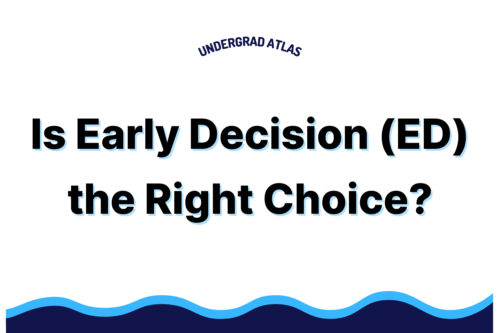Building a college list can be challenging, but it is crucial for a successful college application process. If you’re a high school student who’s starting to feel overwhelmed by the daunting task of creating a college list, keep reading!
In this article, we will discuss the importance of creating a balanced college list and provide practical tips on how to build one. By following these guidelines, you can increase your chances of admission and reduce stress during the decision period.
The Challenge of Creating a College List
Creating a college list can be a daunting task, especially with the limitations of the CommonApp, which restricts students to 20 colleges. Despite this reasonable number, many students still struggle to manage their list effectively.
When thinking about where to apply, students often have two main considerations. Firstly, they have a specific dream school in mind—the one they imagine when asked about their college aspirations. These dream schools are usually prestigious institutions like Harvard, Stanford, or Yale. Secondly, students consider general characteristics that they want in a college, such as size or location.
However, it is important to recognize that the college you dream of may not be the best fit for you academically, financially, or culturally. It is crucial to strike a balance between aspiration and realism.
The Pitfalls of Aspirational College Lists
To create a bulletproof college list, it is essential to have a realistic understanding of the current college admissions landscape. Unfortunately, many students and parents fall into three common pitfalls:
- Lack of Creativity: Students often lack creativity when selecting their reach schools. They tend to focus on the same prestigious universities repeatedly, even though these schools may be far from realistic options.
- Too Much Optimism: Applicants tend to be overly optimistic when choosing target schools. They look at acceptance rates and test score medians, but fail to consider the competitive nature of admissions. As a result, their target schools become more like reaches.
- Overconfidence in Safeties: Students may become too confident in their safety schools, treating them as guaranteed acceptances. Consequently, they end up with too few safeties and a top-heavy list.
These tendencies lead to imbalanced lists with limited safeties, too many unrealistic reach schools, and a narrow selection of ambitious target schools. Given the decreasing acceptance rates across the board, this expectation inflation can have disastrous effects.
Adopting a Proactive Pessimism Approach
To counteract expectation inflation and build a balanced college list, it is essential to adopt a healthy attitude of proactive pessimism. This does not mean giving up hope or procrastinating until the last minute. Instead, it means developing a list that accounts for worst-case scenarios and ensures a higher margin of confidence for each category of schools.
For example, a student should have safeties that they can confidently rely on, target schools that are within their reach, and a reasonable selection of reach schools that are challenging yet still possible. By embracing this approach, students can increase their acceptance rates and avoid unnecessary anxiety and disappointment.
Building a College List: A Step-by-Step Guide
- Start with Research: Begin the college list-building process by conducting thorough research. Platforms such as Niche.com offer comprehensive information and reviews about various colleges. Use these tools to gather insights about academics, diversity, campus life, professors, and other key factors.
- Categorize Your Schools: Divide your schools into three categories: safeties, targets, and reaches. This classification should be based on a realistic assessment of your academic credentials in relation to the acceptance profiles of each college. Aim for a balanced distribution among these categories.
- Include Safety Schools: Safety schools are those where your academic profile places you well above the average admitted student. Choose schools in which your hard stats, such as GPA and test scores, rank comfortably within the 60th-80th percentile.
- Select Target Schools: Target schools should be universities where your academic profile matches (or slightly exceeds) the 50th percentile of admitted students. Consider schools where you have a reasonable chance of acceptance based on your achievements and qualifications.
- Identify Reach Schools: Reach schools are those where your academic profile falls below the 50th percentile of admitted students. It is crucial to be realistic and avoid applying to highly selective schools where your chances of acceptance are minimal. Aim for a percentile range between the 20th and 45th percentiles.
- Add a Variety of Schools: Ideally, your college list should include a mix of state and private institutions, as well as both larger and smaller schools. Consider factors such as location, campus culture, and available resources when making your selections.
- Research Deeply: While platforms like Niche.com provide valuable insights, do not rely solely on them. Explore the official websites of the schools on your list to gather more in-depth information about academics, extracurricular activities, and campus life.
Sample College List for Mike Doe
To illustrate the process, let’s use an example. Mike Doe is a student with a GPA of 3.58, an SAT score of 1350, and a desire to double major in Computer Science and Biology. Mike’s goal is to find a school with strong research opportunities, regardless of size or location.
Based on these criteria, here is a sample college list for Mike:
Reach:
- University of Texas at Austin
- University of Florida
- University of California, Irvine
- University of California, Santa Barbara
Target:
- University of Wisconsin
- University of Georgia
- University of Washington
- University of California, Davis
- University of California, Santa Cruz
Safety:
- University of Colorado Boulder
- University of Massachusetts Amherst
- Arizona State University
- University of California, Merced
- University of California, Riverside
By following this approach, Mike creates a college list that includes a balanced mix of reach, target, and safety schools. This well-rounded list enhances his chances of admission while considering his academic qualifications and career goals.
Conclusion
Building a balanced college list is crucial for a successful college admissions process. By adopting a proactive pessimism approach and conducting thorough research, you can create a list that includes realistic reach, target, and safety schools. Remember to consider factors beyond rankings, such as campus culture, location, and available resources.
By following these guidelines, you will increase your chances of admission and set yourself up for a successful college experience. So, start building your college list today and embark on your journey toward higher education!





